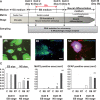Identification of Stage-Specific Gene Expression Signatures in Response to Retinoic Acid during the Neural Differentiation of Mouse Embryonic Stem Cells
- PMID: 22891073
- PMCID: PMC3413097
- DOI: 10.3389/fgene.2012.00141
Identification of Stage-Specific Gene Expression Signatures in Response to Retinoic Acid during the Neural Differentiation of Mouse Embryonic Stem Cells
Abstract
We have previously established a protocol for the neural differentiation of mouse embryonic stem cells (mESCs) as an efficient tool to evaluate the neurodevelopmental toxicity of environmental chemicals. Here, we described a multivariate bioinformatic approach to identify the stage-specific gene sets associated with neural differentiation of mESCs. We exposed mESCs (B6G-2 cells) to 10(-8) or 10(-7) M of retinoic acid (RA) for 4 days during embryoid body formation and then performed morphological analysis on day of differentiation (DoD) 8 and 36, or genomic microarray analysis on DoD 0, 2, 8, and 36. Three gene sets, namely a literature-based gene set (set 1), an analysis-based gene set (set 2) using self-organizing map and principal component analysis, and an enrichment gene set (set 3), were selected by the combined use of knowledge from literatures and gene information selected from the microarray data. A gene network analysis for each gene set was then performed using Bayesian statistics to identify stage-specific gene expression signatures in response to RA during mESC neural differentiation. Our results showed that RA significantly increased the size of neurosphere, neuronal cells, and glial cells on DoD 36. In addition, the gene network analysis showed that glial fibrillary acidic protein, a neural marker, remarkably up-regulates the other genes in gene set 1 and 3, and Gbx2, a neural development marker, significantly up-regulates the other genes in gene set 2 on DoD 36 in the presence of RA. These findings suggest that our protocol for identification of developmental stage-specific gene expression and interaction is a useful method for the screening of environmental chemical toxicity during neurodevelopmental periods.
Keywords: Bayesian network; mouse embryonic stem cells; neural differentiation; retinoic acid; toxicity screening.
Figures








Similar articles
-
Neural differentiation of mouse embryonic stem cells as a tool to assess developmental neurotoxicity in vitro.Neurotoxicology. 2012 Oct;33(5):1135-46. doi: 10.1016/j.neuro.2012.06.006. Epub 2012 Jun 23. Neurotoxicology. 2012. PMID: 22732190
-
Multi-parametric profiling network based on gene expression and phenotype data: a novel approach to developmental neurotoxicity testing.Int J Mol Sci. 2012;13(1):187-207. doi: 10.3390/ijms13010187. Epub 2011 Dec 23. Int J Mol Sci. 2012. PMID: 22312247 Free PMC article.
-
Neuronal Differentiation from Mouse Embryonic Stem Cells In vitro.J Vis Exp. 2020 Jun 2;(160). doi: 10.3791/61190. J Vis Exp. 2020. PMID: 32568233
-
[Neural differentiation of pluripotent stem cells and application for metal-induced neural toxicity study].Yakugaku Zasshi. 2014;134(7):793-5. doi: 10.1248/yakushi.14-00017-3. Yakugaku Zasshi. 2014. PMID: 24989467 Review. Japanese.
-
Retinoic acid signaling and mouse embryonic stem cell differentiation: Cross talk between genomic and non-genomic effects of RA.Biochim Biophys Acta. 2015 Jan;1851(1):66-75. doi: 10.1016/j.bbalip.2014.04.003. Epub 2014 Apr 24. Biochim Biophys Acta. 2015. PMID: 24768681 Review.
Cited by
-
Transcriptomic analysis of murine embryos lacking endogenous retinoic acid signaling.PLoS One. 2013 Apr 24;8(4):e62274. doi: 10.1371/journal.pone.0062274. Print 2013. PLoS One. 2013. PMID: 23638021 Free PMC article.
-
Implications of the Wnt5a/CaMKII pathway in retinoic acid-induced myogenic tongue abnormalities of developing mice.Sci Rep. 2014 Aug 15;4:6082. doi: 10.1038/srep06082. Sci Rep. 2014. PMID: 25124193 Free PMC article.
-
Retinoic acid signaling and neuronal differentiation.Cell Mol Life Sci. 2015 Apr;72(8):1559-76. doi: 10.1007/s00018-014-1815-9. Epub 2015 Jan 6. Cell Mol Life Sci. 2015. PMID: 25558812 Free PMC article. Review.
-
Proteomic Studies of Primary Acute Myeloid Leukemia Cells Derived from Patients Before and during Disease-Stabilizing Treatment Based on All-Trans Retinoic Acid and Valproic Acid.Cancers (Basel). 2021 Apr 29;13(9):2143. doi: 10.3390/cancers13092143. Cancers (Basel). 2021. PMID: 33946813 Free PMC article.
-
Global Developmental Gene Programing Involves a Nuclear Form of Fibroblast Growth Factor Receptor-1 (FGFR1).PLoS One. 2015 Apr 29;10(4):e0123380. doi: 10.1371/journal.pone.0123380. eCollection 2015. PLoS One. 2015. PMID: 25923916 Free PMC article.
References
-
- Catena R., Tiveron C., Ronchi A., Porta S., Ferri A., Tatangelo L., Cavallaro M., Favaro R., Ottolenghi S., Reinbold R., Schöler H., Nicolis S. K. (2004). Conserved POU binding DNA sites in the Sox2 upstream enhancer regulate gene expression in embryonic and neural stem cells. J. Biol. Chem. 279, 41846–4185710.1074/jbc.M405514200 - DOI - PubMed
LinkOut - more resources
Full Text Sources
Research Materials

